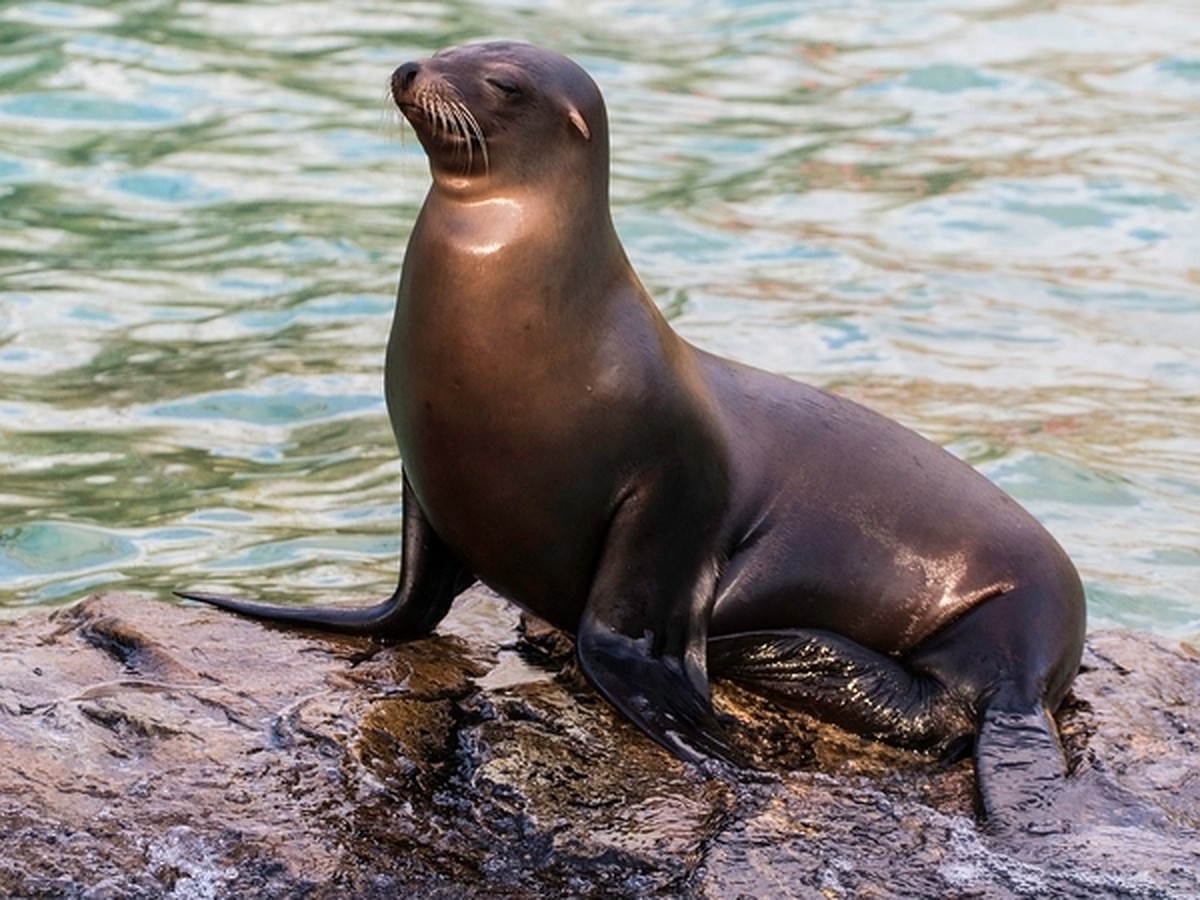Their lion-like roar has given sea lions their name. The powerful predators live in the sea and are perfectly adapted to life in the water.
Characteristics
What do sea lions look like?
Sea lions belong to the order of carnivores and there to the family of eared seals. They form the genus-group Otariini with six different species.
Their body is elongated and the front and hind legs are transformed into flippers. The small head with the short snout sits on a short, strong neck.
Unlike seals, sea lions have tiny pinnae on their heads and their rear finned limbs are much longer. You can also fold them forward under your stomach. They can move faster and more skilfully on land than seals.
The males of all sea lion species are significantly larger than the females. When they rear up on their front flippers, the largest specimens are more than two meters tall. The males have a mane and their roar sounds like that of a real lion.

The fur of sea lions is dark brown, very dense, and water-repellent, and consists of stem hair and guard hair. Because a fine undercoat is almost entirely absent, it lies close to the body. A thick layer of fat, the so-called blubber, is typical. He protects the animals from the cold water.
Where does the sea lion live?
Sea lions are native to the Pacific coast of North America, the Pacific and Atlantic coasts of South America, around the Galapagos Islands, and the coasts of Australia and New Zealand. Sea lions are sea creatures and live mainly on rocky coasts. However, they go ashore to mate, give birth, and raise the young.
What species of sea lions are there?
The best-known species are the California sea lions (Zalophus californianus). Living on the west coast of North America from Canada to Mexico, they are the smallest and lightest of all sea lions and their snout is longer and more slender than the other species. The males grow up to 220 centimeters, the females up to 170 centimeters long.
The most powerful are Steller’s sea lions (Eumetopias jubatus). The males are up to three and a half meters long and weigh over a ton, the females measure only 240 centimeters and weigh up to 300 kilograms. They live primarily on the northern Pacific coasts of Asia and North America.
The New Zealand sea lions (Phocarctos hookeri) are also relatively small: the males are up to 245 centimeters long, the females a maximum of 200 centimeters. They live on sub-Antarctic islands around New Zealand and on the coasts of New Zealand’s South Island.
The Australian sea lions (Neophoca cinerea) mainly inhabit the islands off the coasts of western and southern Australia. The males measure up to 250 centimeters, the females up to 180 centimeters. The South American sea lions, also known as mane seals (Otaria flavescens), live on the Pacific coast of South America from Peru to Tierra del Fuego and on the Atlantic coast from the southern tip to southern Brazil. The males are 250 centimeters long, the females are 200 centimeters.
As their name suggests, Galápagos sea lions live in the Pacific Ocean on the coasts of the Galapagos Islands about 1000 kilometers west of Ecuador. The males grow up to 270 centimeters, the females only 150 to 170 centimeters long.
How old do sea lions get?
Depending on the species, sea lions live 12 to 14 years, but some animals can live up to 20 years.
Behave

How do sea lions live?
Sea lions are excellently adapted to life in cold seas: With their streamlined body and legs that have been converted into flippers, they can swim very agilely and elegantly and can reach speeds of up to 40 kilometers per hour in the water.
A thick layer of fat, the blubber, protects the animals from the cold seawater. If it gets very cold, sea lions can also throttle the blood supply to the outer regions of the body in order not to lose heat and cool down.
In addition, thanks to various adaptations of their body, they can dive for up to 15 minutes and up to 170 meters deep: They can store a lot of air, their blood binds a lot of oxygen, and when diving, the pulse slows down so that the body uses less oxygen. They can also close their nostrils tightly when diving.
With their light-sensitive eyes, they see well in dark and murky water. They use their very good sense of smell to find their way around on land. Their sensory hairs in the mustache and on the head serve as organs of touch. In addition, sea lions use an echo-sounding system: they emit sounds underwater and orient themselves on their echo.
Although sea lions are considered aggressive, they are shy in the wild and tend to flee when they see humans. When the females have young, they defend them very fiercely. In the case of sea lions, the males, i.e. the males, keep a harem which they fiercely defend against male conspecifics.
